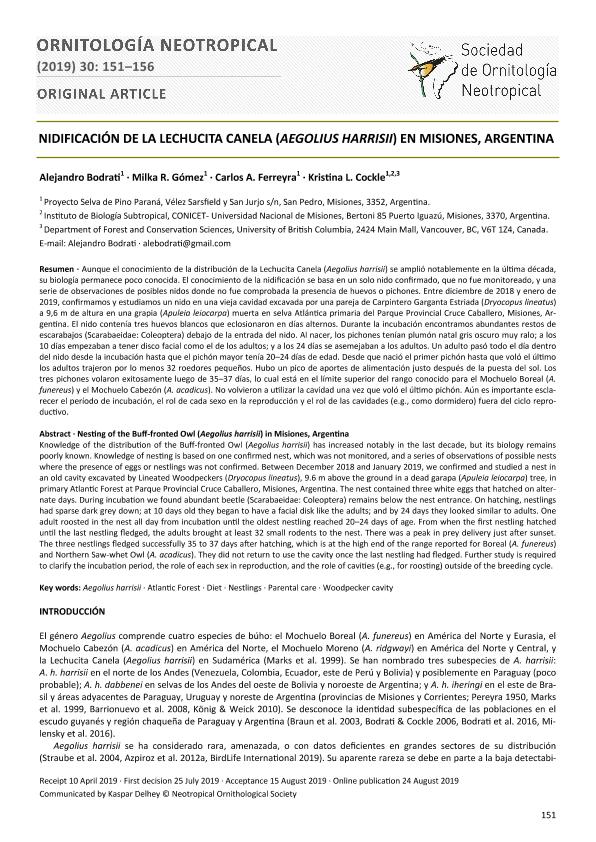Artículo
Aunque el conocimiento de la distribución de la Lechucita Canela (Aegolius harrisii) se amplió notablemente en la última década, su biología permanece poco conocida. El conocimiento de la nidificación se basa en un solo nido confirmado, que no fue monitoreado, y una serie de observaciones de posibles nidos donde no fue comprobada la presencia de huevos o pichones. Entre diciembre de 2018 y enero de 2019, confirmamos y estudiamos un nido en una vieja cavidad excavada por una pareja de Carpintero Garganta Estriada (Dryocopus lineatus) a 9,6 m de altura en una grapia (Apuleia leiocarpa) muerta en selva Atlántica primaria del Parque Provincial Cruce Caballero, Misiones, Argentina. El nido contenía tres huevos blancos que eclosionaron en días alternos. Durante la incubación encontramos abundantes restos de escarabajos (Scarabaeidae: Coleoptera) debajo de la entrada del nido. Al nacer, los pichones tenían plumón natal gris oscuro muy ralo; a los 10 días empezaban a tener disco facial como el de los adultos; y a los 24 días se asemejaban a los adultos. Un adulto pasó todo el día dentro del nido desde la incubación hasta que el pichón mayor tenía 20?24 días de edad. Desde que nació el primer pichón hasta que voló el último los adultos trajeron por lo menos 32 roedores pequeños. Hubo un pico de aportes de alimentación justo después de la puesta del sol. Los tres pichones volaron exitosamente luego de 35?37 días, lo cual está en el límite superior del rango conocido para el Mochuelo Boreal (A. funereus) y el Mochuelo Cabezón (A. acadicus). No volvieron a utilizar la cavidad una vez que voló el último pichón. Aún es importante esclarecer el período de incubación, el rol de cada sexo en la reproducción y el rol de las cavidades (e.g., como dormidero) fuera del ciclo reproductivo. Nesting of the Buff-fronted Owl (Aegolius harrisii) in Misiones, Argentina Knowledge of the distribution of the Buff-fronted Owl (Aegolius harrisii) has increased notably in the last decade, but its biology remains poorly known. Knowledge of nesting is based on one confirmed nest, which was not monitored, and a series of observations of possible nests where the presence of eggs or nestlings was not confirmed. Between December 2018 and January 2019, we confirmed and studied a nest in an old cavity excavated by Lineated Woodpeckers (Dryocopus lineatus), 9.6 m above the ground in a dead garapa (Apuleia leiocarpa) tree, in primary Atlantic Forest at Parque Provincial Cruce Caballero, Misiones, Argentina. The nest contained three white eggs that hatched on alternate days. During incubation we found abundant beetle (Scarabaeidae: Coleoptera) remains below the nest entrance. On hatching, nestlings had sparse dark grey down; at 10 days old they began to have a facial disk like the adults; and by 24 days they looked similar to adults. One adult roosted in the nest all day from incubation until the oldest nestling reached 20–24 days of age. From when the first nestling hatched until the last nestling fledged, the adults brought at least 32 small rodents to the nest. There was a peak in prey delivery just after sunset. The three nestlings fledged successfully 35 to 37 days after hatching, which is at the high end of the range reported for Boreal (A. funereus) and Northern Saw-whet Owl (A. acadicus). They did not return to use the cavity once the last nestling had fledged. Further study is required to clarify the incubation period, the role of each sex in reproduction, and the role of cavities (e.g., for roosting) outside of the breeding cycle.
Nidificación de la lechucita canela (aegolius harrisii) en Misiones, Argentina
Título:
Nesting of the Buff-fronted Owl (Aegolius harrisii) in Misiones, Argentina
Fecha de publicación:
08/2019
Editorial:
Neotropical Ornithological Society
Revista:
Ornitología Neotropical
ISSN:
1075-4377
Idioma:
Español
Tipo de recurso:
Artículo publicado
Clasificación temática:
Resumen
Archivos asociados
Licencia
Identificadores
Colecciones
Articulos(IBS)
Articulos de INSTITUTO DE BIOLOGIA SUBTROPICAL
Articulos de INSTITUTO DE BIOLOGIA SUBTROPICAL
Citación
Bodrati, Alejandro; Gómez, Milka Raquel; Ferreyra, Carlos A.; Cockle, Kristina Louise; Nidificación de la lechucita canela (aegolius harrisii) en Misiones, Argentina; Neotropical Ornithological Society; Ornitología Neotropical; 30; 8-2019; 151-156
Compartir




